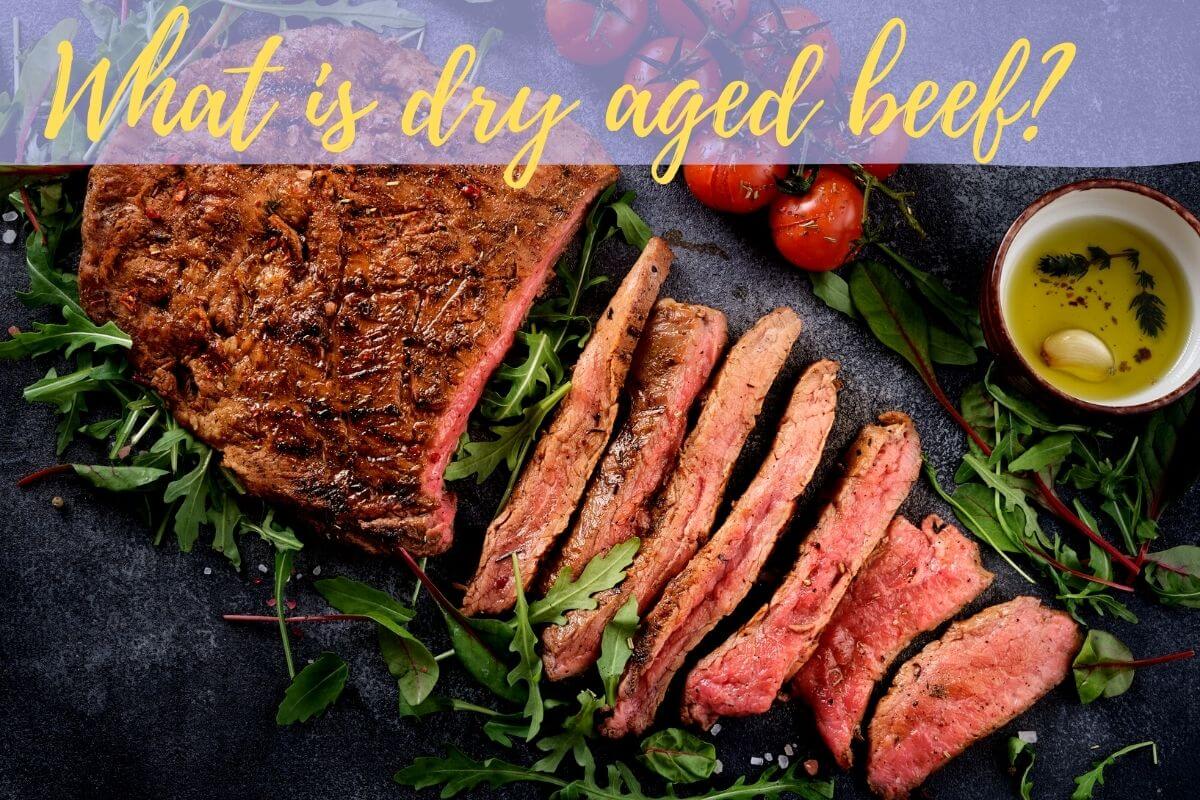When it comes to the finest beef experience, dry aged beef is a cut above the rest. Thus, what is dry aged beef? Dry aged beef is premium quality meat that has been hung and dried in a temperature-controlled environment for a period of time, usually ranging from two weeks to six months.
This process evaporates moisture over time, providing an intense flavor and unique texture.
What is Dry Aged Beef?
Dry aged beef is meat that has been hung and dried in a temperature-controlled environment for extended periods of time. This process allows the moisture to evaporate, giving the resulting product an intense flavor with a unique texture.
Generally, the longer the aging process, the better the flavor and texture will be. Dry aged beef may have a more intense flavor and firmer texture than what is typically found in freshly cut meat.
The Benefits of Dry Aged Beef
Dry aging beef is a delicate process that requires careful monitoring to ensure that the meat reaches its peak flavor and texture, but the results are worth it. In addition to providing an intense flavor and unique texture, dry aged beef also has a higher level of essential amino acids, making it a healthier option than what is typically found in grocery stores.
For those looking for the ultimate culinary experience, there’s no better option than dry aged beef. With its intense flavor and unique texture, it can elevate any dish to something truly special. Whether you opt for a steak, roast, or burger, you’ll be sure to savor the flavor and texture of dry aged beef.
When it comes to what is arguably the finest beef experience, dry aged beef is a cut above the rest. Discover what makes this gourmet delight so special with its intense flavor and unique texture that can elevate any dish.
Process of Dry Aging Beef
The process of dry aging beef begins with a carefully-selected cut of meat, typically the rib or loin. The meat is trimmed and then placed in a temperature-controlled room that is kept between 33°F to 37°F (1°C to 3°C ). The relative humidity is usually kept around 75-80%. This environment is then monitored regularly to ensure constant temperature and humidity.
|Read: Discover the World of Luxury: The Cost of Mouth-Watering Wagyu Beef
Once the meat has been placed in the temperature-controlled room, it will lose moisture over time as the water evaporates from the cut’s exterior. During this period, enzymes and bacteria will tenderize the meat, giving it the unique flavor and texture associated with dry aged beef. During this period, the outside layer of the cut will form what’s known as a “crust” which is dried and often covered in molds. The crust should be trimmed off before cooking.
The process of dry aging beef can be time-consuming and expensive, but the end result is well worth it. If you’re looking for an intense flavor and unique texture, there’s no better option than dry aged beef.
Investing in high-quality cuts of meat and taking the time to dry age them correctly can create an unforgettable culinary experience. With its intense flavor and unique texture, there’s no denying that dry aged beef is the ultimate fine beef experience.
The Optimal Length of Dry Aging Beef Process
The best length of time for the beef to dry-age depends on how you like it and what cut it is. Most of the time, it’s best to dry-age beef for at least 14 to 21 days to improve its flavor, tenderness, and richness.
Some beef enthusiasts may prefer to age their beef for longer periods, up to 45 days or more, to achieve a more intense flavor and buttery texture. However, longer aging times may also result in a greater loss of moisture and weight, which may increase the cost of the meat.
Common Dry Aged Beef Characters
There are a few characteristics common to dry aged beef. Generally, the flavor will be more intense than what is typically found in freshly cut meat and the texture may be a bit firmer. The color of the beef will also be darker with drier fat content, which helps to create an even more intense flavor profile.
- Flavor
- Texture
- Color
Flavor
The intense flavor of dry aged beef comes directly from the aging process. As the moisture evaporates, the outside layer develops what’s known as a “crust” which is dried and often covered in molds. This crust helps increase the flavor’s intensity by concentrating certain natural compounds in the meat.
Texture
The texture of dry aged beef is what sets it apart from what you’ll find in the grocery store. As the meat ages, its proteins and fats break down, resulting in a tender texture that melts in your mouth. The longer the beef is aged, the better the flavor and texture will be.
Color
The color of dry aged beef is darker than what is typically found in freshly cut meat. This comes from the aging process, as moisture evaporates, leaving a concentrated flavor profile behind. The fat content will also be drier and darker than what you’ll find in other cuts of beef.
Dry Aged vs. Wet Aged Methods

Dry-aged beef is aged by hanging the meat in a controlled environment with low humidity, allowing natural enzymes to break down the meat’s fibers and enhance its flavor, resulting in a tender, intense, and nutty taste.
Wet-aged beef is aged in vacuum-sealed plastic bags, retaining moisture and producing a meaty and juicy taste.
|Read: Get Most Out of Your Corned Beef: How to Cut it Like a Chef
Additionally, they’re different in terms of cost and availability. Dry-aged beef is harder to find in stores and tends to be more expensive, while wet-aged beef is more readily available at a lower price.
Frequent Asked Questions
Why does dry aged meat not spoil when drying?
The beef is kept in a controlled environment with low humidity and good air circulation during dry aging. This prevents the growth of harmful bacteria and allows natural enzymes to break down the meat fibers, resulting in a more intense flavor, tenderness, and aroma.
The outer layer of the meat exposed to air becomes hard and dry, further protecting the inner meat from spoilage.
Is dry-aged beef better than other alternatives?
Dry-aged beef is a matter of personal preference. It has a more concentrated, nutty, and intense flavor due to moisture loss, which appeals to some people.
However, others may prefer the taste of non-dry-aged beef, which has a fresher, meatier, and juicier flavor.
What are the benefits of dry aged beef?
- Enhanced flavor: Dry aging concentrates the flavor of the beef, giving it a rich, nutty, and meaty taste that is more complex than non-aged beef.
- Tender texture: The natural enzymes in the meat break down the connective tissue, making the beef more tender and juicy.
- Improved aroma: Dry aging results in a distinctive aroma that adds to the overall sensory experience of eating beef.
Is dry aged meat healthy to eat?
There are no significant health benefits or risks associated with consuming dry-aged beef compared to non-dry-aged beef. However, the process of dry aging may result in some loss of moisture and weight, which may lead to a slightly higher concentration of nutrients and calories in dry-aged beef per serving.
How do I cook dry aged beef?
- Bring the beef to room temperature before cooking.
- Season the beef with salt and pepper or other spices of your choice.
- Sear the beef on high heat to create a crust on both sides.
- Finish cooking the beef to your desired level of doneness in the oven, grill, or stovetop.
- Let the beef rest for 5-10 minutes before slicing and serving.
The cooking time will depend on the thickness and cut of the meat, as well as your preferred level of doneness. It’s best to use a meat thermometer to ensure that the beef is cooked to the correct internal temperature.
Does dry aged meat taste different from than normal way of cooking?
Yes, dry-aged beef has a distinct taste compared to non-dry-aged beef. It has a more intense and nutty flavor, and the texture is often more tender and buttery. The longer the aging time, the more pronounced the flavor and texture will be.
How long does dry aged beef last?
Dry-aged beef lasts longer than non-aged beef due to the loss of moisture during the aging process. The length of time that dry-aged beef lasts depends on the storage conditions, but it can last up to 21-28 days or longer if kept in a controlled environment with low humidity and good air circulation.
It’s important to note that the outer layer of the meat may become hard and moldy during the aging process, but it can be trimmed off before cooking.
What is the difference between aged beef and dry-aged beef?
Aged beef generally refers to beef that has been stored for a certain amount of time, either dry-aged or wet-aged. Dry-aged beef is aged in a controlled environment with low humidity, while wet-aged beef is aged in a vacuum-sealed bag.
The main difference between the two is that dry-aged beef has a more intense and concentrated flavor due to the loss of moisture, while wet-aged beef tends to be juicier and meatier due to moisture retention.
—
Dry aged beef is great for bringing intense flavor and complexity to your favorite beef recipes. The process of aging results in an enhanced flavor, tender texture, and improved aroma that make it stand out from other cuts of beef. While there are no significant health benefits or risks associated with consuming dry-aged beef, the quality of the meat is what really matters when it comes to food safety and enjoyment.
No matter what cut you choose, it is important to store and cook it properly so you can enjoy the most delicious dry-aged beef possible. With a little knowledge and care, you can create delicious and satisfying dishes that will impress your friends and family. Happy cooking!
Further Reading:
- Determination of Indicators for Dry Aged Beef Quality – NIH
- Guidelines for U.S. Dry-Aged Beef for International Markets – US Meat Export Federation
- 3 Ways to Dehydrate Meat – wikiHow
- 3 Ways to Cook Dry Aged Steak

I am Benjamin Nunez, and I love Spanish food, Italian food, and seafood. I have worked in kitchens all my life. I started as a dishwasher when I was just a teenager, and worked my way up to being a head chef.
I specialize in Spanish cuisine, but I can make any kind of Italian or seafood dish you want. My kitchen is always open! Website: https://granadarestaurant.com/

